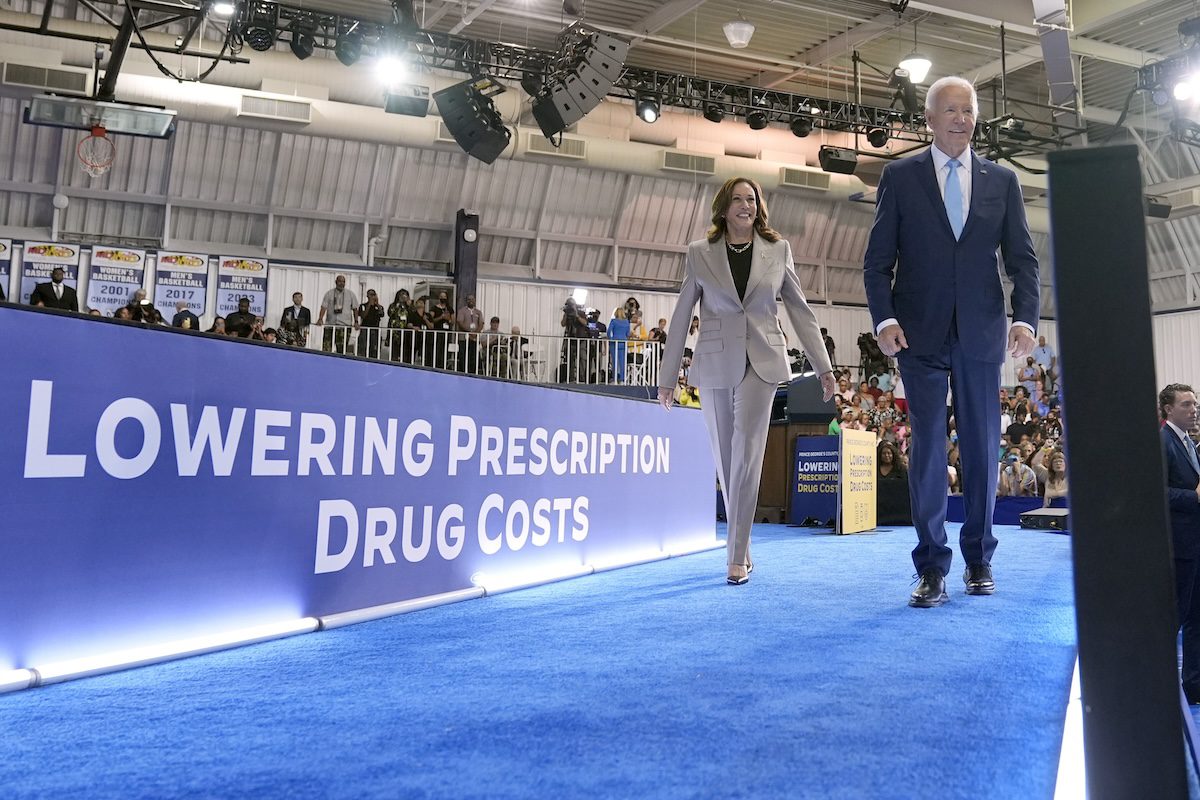
Democratic presidential nominee Vice President Kamala Harris, left, and President Joe Biden depart after speaking about the administration's efforts to lower prescription drug costs during an event at Prince George's Community College in Largo, Md., Thursday, Aug. 15, 2024. (AP Photo/Susan Walsh)
The Inflation Reduction Act ensured that 15,000 Iowans were able to keep their health insurance, reduced the cost of insulin for nearly 19,000 Iowa seniors, and incentivized manufacturers to invest in the state and create more clean energy jobs.
Two years ago today, the Inflation Reduction Act (IRA) was signed into law.
The legislation represented the largest-ever investment in fighting climate change, lowered health care and prescription drug costs, raised taxes on corporations, and boosted funding for the Internal Revenue Service to go after wealthy tax cheats.
The bill was passed with only Democratic votes, with every Iowa Republican in Congress voting against it, despite its potentially transformative impact on the economy and the nation’s clean energy infrastructure.
Here are some highlights of how the Inflation Reduction Act has impacted Iowa:
Lower health care and prescription drug costs
The Inflation Reduction Act extended generous subsidies that helped make Affordable Care Act (ACA) health insurance plans more affordable for working- and middle-class families.
Those subsidies were introduced as part of President Joe Biden’s American Rescue Plan of 2021, and were set to expire at the end of 2022, but the IRA extended them through the end of 2025.
Roughly 15,000 Iowans were set to lose their individual coverage and become uninsured had those subsidies expired at the end of 2022, but thanks to the Inflation Reduction Act, those people got to keep their insurance.
The IRA also reformed Medicare to lower drug costs for many of the 535,524 Iowa seniors with Medicare Part D coverage, which covers prescription drugs.
For example, beginning last year, all vaccines covered under Medicare Part D are free, and the bill implemented a $35 monthly cap on insulin for Medicare recipients.
As a result, nearly 19,000 Iowa seniors on Medicare who use insulin are now charged no more than $35 per month for an insulin prescription.
The IRA will also implement a $2,000 cap on Medicare recipients’ annual out-of-pocket prescription drug costs, beginning in 2025. In Iowa, an estimated 163,690 seniors are expected to save $525 a year each due to this provision, according to an analysis by the US Department of Health and Human Services.
Additionally, the law authorized Medicare to negotiate prices for expensive drugs with pharmaceutical companies for the first time. On Thursday, the Biden-Harris administration announced the new, lower prices of 10 expensive and widely-used drugs that were selected last year for the first round of negotiations.
The negotiations — which used the power of Medicare to lower drug costs for seniors — are expected to save taxpayers about $6 billion in 2026, when they go into effect. The new prices will be anywhere from 38% to 79% lower than the drugs’ list prices last year, saving seniors on Medicare an estimated $1.5 billion in out-of-pocket costs in 2026 alone.
Fighting climate change and saving families money on energy
Arguably the most critical element of the IRA is its provisions to reduce emissions that cause climate change and drive extreme weather events. The law aims to do this by establishing a mix of tax credits for companies and rebates for consumers in order to make the manufacturing and consumption of clean energy technologies and products cheaper.
In other words: by making clean energy—like solar, wind, and hydropower—cheaper to produce and use, the IRA seeks to hasten the transition away from fossil fuels that are one of the biggest sources of emissions.
For example, under the law, manufacturers get subsidies for building electric vehicles (EVs) and renewable energy products, and utilities get credits for choosing solar and wind energy over fossil fuel plants.
In Iowa, several manufacturers have already taken advantage of the IRA’s incentives.
For example, state regulators approved MidAmerican Energy’s proposal to spend $3.9 billion to build more capacity to generate wind and solar energy in Iowa last year, as well as explore new technologies that could advance the power company’s transition to net-zero greenhouse gas emissions.
The company estimates that this project will create more than 1,100 full-time jobs during the construction phase and another 125 full-time positions for ongoing operations and maintenance. The project will also contribute roughly $24 million annually in local property tax payments and more than $21 million in annual landowner easement payments, according to estimates from MidAmerican Energy.
The IRA also provided $80 billion in financial rebates for millions of households to adopt those clean energy products, such as electric vehicles, solar panels, and more efficient heat pumps.
More than three million American households took advantage of the IRA’s subsidies for homeowners last year, which led to a combined savings of $8 billion, according to data from the Treasury Department. This includes 32,980 Iowa households that saved over $58 million, or $1,760 per household on average.

Paralympic gold medalist Josh Turek launches run against US Sen. Joni Ernst
The Iowa state representative, who won twice in Trump territory, is betting his story of overcoming adversity will resonate statewide. Josh Turek...

Democrat Jackie Norris launches US Senate bid against Joni Ernst
Norris launched her campaign, positioning herself as a problem-solver focused on "invisible burdens" like the mental health and childcare crises...

Iowa constitutional law professor launches third bid against GOP Congresswoman
Christina Bohannan is taking another shot at unseating embattled US Rep. Mariannette Miller-Meeks, after losing by just 799 votes in 2024. Iowa law...

Report: House Republicans’ tax bill heavily favors wealthy Americans
Analysis shows the richest 1% would receive $121 billion in tax cuts while the poorest fifth see only 1% of the benefit. Republicans in the US House...

Top House Democrat predicts Miller-Meeks will lose in 2026
National Democrats see an opportunity to flip Iowa’s 1st Congressional District and take congressional control away from the Trump administration. ...

Guest post: Bohannan campaign showed anti-corporate greed message works
While Christina Bohannan may not have pulled off a victory against incumbent Rep. Mariannette Miller-Meeks this time around, her campaign should be...



